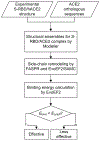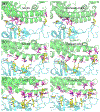Identifying the Zoonotic Origin of SARS-CoV-2 by Modeling the Binding Affinity between the Spike Receptor-Binding Domain and Host ACE2
- PMID: 33175551
- PMCID: PMC7770890
- DOI: 10.1021/acs.jproteome.0c00717
Identifying the Zoonotic Origin of SARS-CoV-2 by Modeling the Binding Affinity between the Spike Receptor-Binding Domain and Host ACE2
Abstract
Despite considerable research progress on SARS-CoV-2, the direct zoonotic origin (intermediate host) of the virus remains ambiguous. The most definitive approach to identify the intermediate host would be the detection of SARS-CoV-2-like coronaviruses in wild animals. However, due to the high number of animal species, it is not feasible to screen all the species in the laboratory. Given that binding to ACE2 proteins is the first step for the coronaviruses to invade host cells, we propose a computational pipeline to identify potential intermediate hosts of SARS-CoV-2 by modeling the binding affinity between the Spike receptor-binding domain (RBD) and host ACE2. Using this pipeline, we systematically examined 285 ACE2 variants from mammals, birds, fish, reptiles, and amphibians, and found that the binding energies calculated for the modeled Spike-RBD/ACE2 complex structures correlated closely with the effectiveness of animal infection as determined by multiple experimental data sets. Built on the optimized binding affinity cutoff, we suggest a set of 96 mammals, including 48 experimentally investigated ones, which are permissive to SARS-CoV-2, with candidates from primates, rodents, and carnivores at the highest risk of infection. Overall, this work not only suggests a limited range of potential intermediate SARS-CoV-2 hosts for further experimental investigation, but also, more importantly, it proposes a new structure-based approach to general zoonotic origin and susceptibility analyses that are critical for human infectious disease control and wildlife protection.
Keywords: EvoEF2 energy unit; SARS-CoV-2; binding affinity; intermediate host; zoonotic origin.
Conflict of interest statement
The authors declare no competing financial interest.
Figures




Update of
-
Identifying zoonotic origin of SARS-CoV-2 by modeling the binding affinity between Spike receptor-binding domain and host ACE2.bioRxiv [Preprint]. 2020 Sep 11:2020.09.11.293449. doi: 10.1101/2020.09.11.293449. bioRxiv. 2020. Update in: J Proteome Res. 2020 Dec 4;19(12):4844-4856. doi: 10.1021/acs.jproteome.0c00717. PMID: 32935105 Free PMC article. Updated. Preprint.
Similar articles
-
Identifying zoonotic origin of SARS-CoV-2 by modeling the binding affinity between Spike receptor-binding domain and host ACE2.bioRxiv [Preprint]. 2020 Sep 11:2020.09.11.293449. doi: 10.1101/2020.09.11.293449. bioRxiv. 2020. Update in: J Proteome Res. 2020 Dec 4;19(12):4844-4856. doi: 10.1021/acs.jproteome.0c00717. PMID: 32935105 Free PMC article. Updated. Preprint.
-
V367F Mutation in SARS-CoV-2 Spike RBD Emerging during the Early Transmission Phase Enhances Viral Infectivity through Increased Human ACE2 Receptor Binding Affinity.J Virol. 2021 Jul 26;95(16):e0061721. doi: 10.1128/JVI.00617-21. Epub 2021 Jul 26. J Virol. 2021. PMID: 34105996 Free PMC article.
-
Functional and genetic analysis of viral receptor ACE2 orthologs reveals a broad potential host range of SARS-CoV-2.Proc Natl Acad Sci U S A. 2021 Mar 23;118(12):e2025373118. doi: 10.1073/pnas.2025373118. Proc Natl Acad Sci U S A. 2021. PMID: 33658332 Free PMC article.
-
Interactions of angiotensin-converting enzyme-2 (ACE2) and SARS-CoV-2 spike receptor-binding domain (RBD): a structural perspective.Mol Biol Rep. 2023 Mar;50(3):2713-2721. doi: 10.1007/s11033-022-08193-4. Epub 2022 Dec 23. Mol Biol Rep. 2023. PMID: 36562937 Free PMC article. Review.
-
Structural basis of severe acute respiratory syndrome coronavirus 2 infection.Curr Opin HIV AIDS. 2021 Jan;16(1):74-81. doi: 10.1097/COH.0000000000000658. Curr Opin HIV AIDS. 2021. PMID: 33186231 Review.
Cited by
-
Zoonotic and Reverse Zoonotic Transmissibility of SARS-CoV-2.Virus Res. 2021 Sep;302:198473. doi: 10.1016/j.virusres.2021.198473. Epub 2021 Jun 9. Virus Res. 2021. PMID: 34118360 Free PMC article. Review.
-
Little Brown Bats (Myotis lucifugus) Support the Binding of SARS-CoV-2 Spike and Are Likely Susceptible to SARS-CoV-2 Infection.Viruses. 2023 Apr 30;15(5):1103. doi: 10.3390/v15051103. Viruses. 2023. PMID: 37243189 Free PMC article.
-
Human Riboviruses: A Comprehensive Study.J Mol Evol. 2025 Feb;93(1):11-37. doi: 10.1007/s00239-024-10221-9. Epub 2024 Dec 31. J Mol Evol. 2025. PMID: 39739017 Review.
-
Variations in Cell Surface ACE2 Levels Alter Direct Binding of SARS-CoV-2 Spike Protein and Viral Infectivity: Implications for Measuring Spike Protein Interactions with Animal ACE2 Orthologs.J Virol. 2022 Sep 14;96(17):e0025622. doi: 10.1128/jvi.00256-22. Epub 2022 Aug 24. J Virol. 2022. PMID: 36000847 Free PMC article.
-
What we know and what we need to know about the origin of SARS-CoV-2.Environ Res. 2021 Sep;200:111785. doi: 10.1016/j.envres.2021.111785. Epub 2021 Jul 28. Environ Res. 2021. PMID: 34329631 Free PMC article.
References
-
- Zhou P; Yang XL; Wang XG; Hu B; Zhang L; Zhang W; Si HR; Zhu Y; Li B; Huang CL; Chen HD; Chen J; Luo Y; Guo H; Jiang RD; Liu MQ; Chen Y; Shen XR; Wang X; Zheng XS; Zhao K; Chen QJ; Deng F; Liu LL; Yan B; Zhan FX; Wang YY; Xiao GF; Shi ZL, A pneumonia outbreak associated with a new coronavirus of probable bat origin. Nature 2020, 579, 270–273. - PMC - PubMed
Publication types
MeSH terms
Substances
Grants and funding
LinkOut - more resources
Full Text Sources
Medical
Miscellaneous

